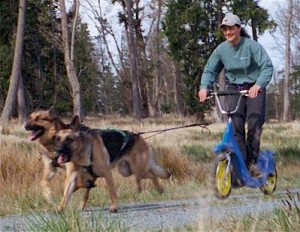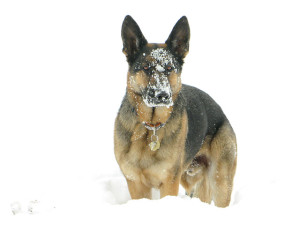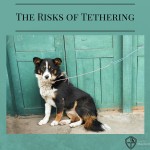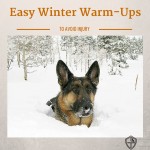Mush On! Shepherds Take the Reins
Mush On with GSDs
When you think of sled (or mush) dogs, do you picture a team of happy Huskies running like the wind on a clear snowy day?
Of course you do! After all, sledding is why the Alaskan Husky breed was created. With amazing endurance and high energy, Huskies are built for sled activities, but there's another dog breed with similar characteristics that can do just as well at hobby sledding and urban mushing on non-snowy surfaces: German Shepherd Dogs!


Why German Shepherd Dogs Make Great Sled Dogs
Like the Alaskan Husky, Shepherds have rugged traits that help them thrive while doing hard work, especially in cold climates. Take one look at a fit German Shepherd Dog (GSD) and it's obvious why these dogs can pull with gusto on snow or asphalt (also known as dryland mushing).
- Their long, muscular bodies are incredibly powerful
- GSDs love to run and work – it's in their DNA!
- They thrive when given a complex mental and physical task to overcome.
When this breed has a job, life is good for both canine and human. Even Cesar Millan recommends sled sports to keep GSDs happy: “For high-energy,working dogs, like Huskies and German Shepherds, think about Urban Mushing - which is essentially dog sledding on city streets with the use of a harness and a scooter, trike, or skateboard.”
Meet Some German Shepherd Dogs on the Trail
Many people are discovering the endless fun that happens with GSD sled dogs:
Husky News spotlights Sam McArthur as one example of a successful dry-land dog sledder with five German Shepherd Dog teammates: “McArthur, 53, enjoys his hobby of dry-land dog mushing almost as much as he loves the five German shepherds that lead him through the trails in the Apalachicola Forests or the Alford Greenway.”


Daphne Lewis, author of “My Dog Likes to Run. I Like to Ride. How to Train Your Dog to Pull You on a Scooter on City Sidewalks & Country Paths,” also shares an example of GSD “scootering” dogs on Sled Dog Central: “Parker and Zeus, Sue Meinzinger's two German Shepherds know how to pull a Sacco cart very fast. They race fall and winter with the Northwest Sled Dog Association. When Sue hitched her shepherds to my Jones Dog Scooter one Sunday afternoon in April, these experienced dogs knew what to do. They took off at a lope down the trail pulling Sue on the scooter easily and fast.”

My own firsthand experience with sled dog sports is why I enjoy sharing the news about this fun activity. On two recent occasions, my German Shepherd (Wyatt) has been an honorary member of the Odaroloc Sled Dog Team in Colorado.

Wyatt is missing a rear leg, so he wasn't allowed to run more than a couple of minutes with a team of older, retired musher dogs, but he still had a blast running with the pack. Odaroloc team captain TC Wait was thrilled to see Wyatt pull with more enthusiasm and heart than she thought he would. “He was made for it!” she told me after his last run.


HOW TO GET STARTED
Before you begin, it pays to research and understand your dog's needs. Take time to:
Visit a vet rehab therapist.
Not all German Shepherds should participate in this sport. “Puppies, dogs with prior injuries or older dogs with arthritis should not take part in dry-land activities,” says Wait in her article for The Wildest. It pays to have your dog evaluated by a qualified veterinary canine rehabilitation therapist because they can uncover potential orthopedic issues that aren't yet obvious, but could be exacerbated by hard, physical activity.
Research a sled dog sport you'll both love.
From carting to canicross, sledding to scooterjoring, you'll discover many year-round activities to keep you and your pup fit. Two great resources to visit are Sled Dog Central and Mushing.com, both of which will pique your interest and share tons of tips to begin.
Talk to other GSD sled dog owners.
Search the web with a phrase like “German Shepherd sled dog” and you'll be surprised at the number of German Shepherds who enjoy this rewarding activity with their pack.
When you think you're ready to start, take the advice of seasoned musher Wait:
- Train up slowly and always, always keeping it fun. Leave 'em wanting more!
- Don't feed/water right before or after working them. We give a good two hours for food, and no water if they are still panting afterwards, then just little drinks at a time.
- Make sure you have a properly fitted harness with padding. If it doesn't fit right it will hurt or rub and won't be fun.
- Be consistent with commands. Typically “gee” for right, “haw” for left, “whoa” to slow down, and an excited “let's go!” or “hike, hike” to go. “On-by” is a good one for moving past a distraction (like small yippy dogs or sticky children).
Ready to get started? Mush on and have fun!
Article By:
Rene Agredano
Tripawds






